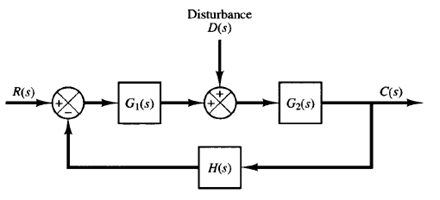Closed-loop System Subjected To A Disturbance
Closed-loop system subjected to a disturbance

Fig: 1 Closed-loop system subjected to a disturbance.
Figure 1 shows a closed loop system subjected to a disturbance. When two inputs (the reference input and disturbance) are present in a linear system, each input can be treated independently of the other; and the outputs corresponding to each input alone can be added to give the complete output. The way each input is introduced into the system is shown at the summing point by either a plus or minus sign.
Consider the system shown in Figure 1. In examining the effect of the disturbance D(s), we may assume that the system is at rest initially with zero error; we may then calculate the response CD(s) to the disturbance only. This response can be found from

On the other hand, in considering the response to the reference input R(s), we may assume that the disturbance is zero. Then the response CR(S) to the reference input R(s) can be obtained from

The response to the simultaneous application of the reference input and disturbance can be obtained by adding the two individual responses. In other words, the response C(s) due to the simultaneous application of the reference input R(s) and disturbance D(s) is given by

Consider now the case where |G1(s)H(s)| >> 1 and |G1(s)G2(s)H(s)| >> 1. In this case, the closed-loop transfer function CD(s)/D(s) becomes almost zero, and the effect of the disturbance is suppressed. This is an advantage of the closed-loop system.
On the other hand, the closed-loop transfer function CR(s)/R(s) approaches 1/H(s) as the gain of G1(S)G2(S)H(s) increases. This means that if |G1(s)G2(s)H(s)| >> 1 then the closed-loop transfer function CR(s)/R(s) becomes independent of G1(s) and G2(S) and becomes inversely proportional to H(s) so that the variations of G1(s) and G2(s) do not affect the closed-loop transfer function CR(s)/R(s). This is another advantage of the closed-loop system. It can easily be seen that any closed-loop system with unity feedback, H(s) = 1, tends to equalize the input and output.